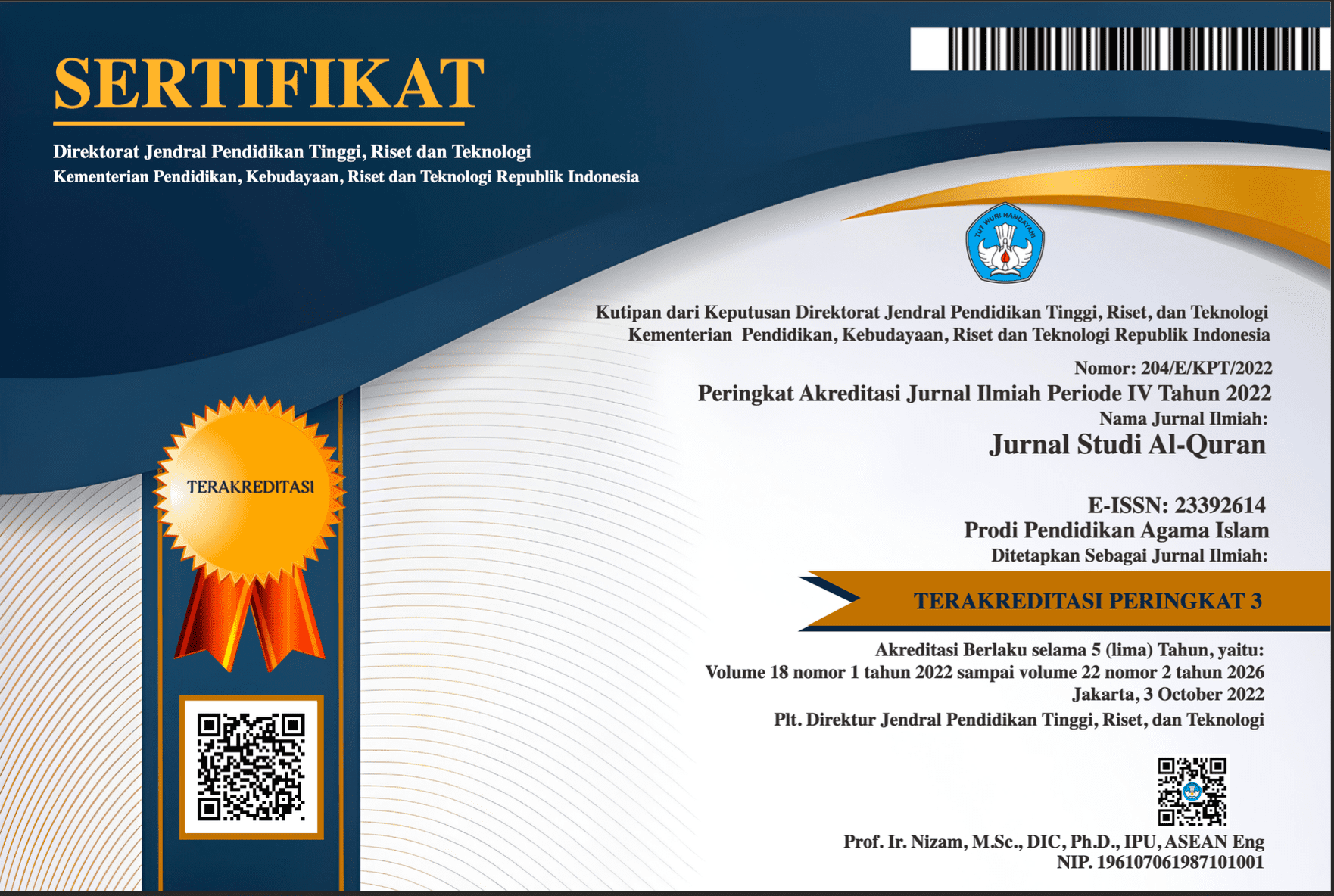Pembelajaran Al-Quran Berbasis Edutainment
Impementasi pengembangan media pembelajaran Kartu Tahfidz
DOI:
https://doi.org/10.21009/JSQ.017.1.04Keywords:
Learning Media, Memorizing Card, EdutainmentAbstract
This study aims to develop learning media in the form of Tahfizh cards in the learning process of memorizing Al-Quran with an edutainment approach. Tahfizh card is a learning medium in the form of cards that discusses learning to memorize the Qur'an, especially the short letters listed in juz 30 in a fun way that is suitable for children. The method used in this research is a research and development method using the Hanafin and Peck models. The techniques used in data collection were observation, interviews, and questionnaires. The results of this study indicate that the Tahfizh Card game learning media obtained value through the validation of media experts and theorists with the "very good" category of 96%. The edutainment approach in the process of learning the Qur'an and memorizing the Qur'an is very helpful for students, where it is a fun element that makes them not overwhelmed in the memorization process.
References
Fahmi, Nadia Noor. Penerapan Edutainment Dalam Pembelajaran Ilmu Pengetahuan Sosial Di MI Muhammadiyah Wirasana Purbalingga. Purwokerto, 2018.
Mukaffan. “Trend Edutainment Dalam Metode Pembelajaran Pendidikan Agama Islam” (2013).
Priyono. “The Implementation of PAIKEM (Active, Innovative, Creative, Effective, and Exiting Learning) and Conventional Learning Method to Improve Student Learning Results.” Journal of Social Studies Education Research 9, no. 2 (2018): 124–137.
Siregar, Pariang Sonang, Lia Wardani, and Rindi Genesa Hatika. “Penerapan Pendekatan Pembelajaran Aktif Inovatif Kreatif Efektif Dan Menyenangkan (Paikem) Pada Pembelajaran Matematika Kelas Iv Sd Negeri 010 Rambah.” Jurnal Pemikiran dan Pengembangan Sekolah Dasar (JP2SD) 5, no. 2 (2017): 743.
Emzir. (2010). Metodologi Penelitian Pendidikan Kuantitatif dan Kualitatif. Rajawali Press.
Fahmi, N. N. (2018). Penerapan Edutainment Dalam Pembelajaran Ilmu Pengetahuan Sosial di MI Muhammadiyah Wirasana Purbalingga.
Hamalik, O. (1989). Media Pendidikan. Citra Aditya.
Hamruni. (2008). Konsep Edutainment dalam Pendidikan Islam.
Hannafin Micahel J & Peck, K. L. (1988). The Design, Development, and Evaluation of Instructional Software (M. P. Company (ed.)).
Ibrahim R, N. S. (2003). Perencanaan Pengajaran. Rineka Cipta.
Moh.Sholeh Hamid. (2011). Metode Edutainment (Sawitri Nawang (ed.)). DIVA Press.
Mukaffan. (2013). Trend Edutainment Dalam Metode Pembelajaran Pendidikan Agama Islam.
Musfiqon. (2012). Pengembangan Media dan Sumber Pelajaran. PT Prestasi Pustakarya.
Ningsih, T. (2016). Pengembangan Alat Permainan Edukatif (Ape) “Kartu Baca-Ngaji Asyik” Sebagai Media Belajar Bagi Anak Usia Dini Di Tk Aisyiyah Kecamatan Sokaraja Kabupaten Banyumas. Jurnal Penelitian Agama, 17(2), 199–215. https://doi.org/10.24090/jpa.v17i2.2016.pp199-215
Priyono. (2018). The implementation of PAIKEM (Active, innovative, creative, effective, and exiting learning) and conventional learning method to improve student learning results. Journal of Social Studies Education Research, 9(2), 124–137. https://doi.org/10.17499/jsser.65763
Purwanto. (2010). Metode Penelitian Kuantitatif untuk Psikologi dan Pendidikan. Pustaka Belajar.
Sadiman, A. S. (2010). Media Pendidikan : Pengertian, Pengembangan dan Pemanfaatannya. Rajawali Pers.
Shalahuddin, M. (1986). Media Pendidikan Agama. Bina Insan.
Siregar, P. S., Wardani, L., & Hatika, R. G. (2017). Penerapan Pendekatan Pembelajaran Aktif Inovatif Kreatif Efektif Dan Menyenangkan (Paikem) Pada Pembelajaran Matematika Kelas Iv Sd Negeri 010 Rambah. Jurnal Pemikiran Dan Pengembangan Sekolah Dasar (JP2SD), 5(2), 743. https://doi.org/10.22219/jp2sd.vol5.no2.743-749
Sugiyono. (2010). Metode Penelitian Kuantitatif Kualitatif dan R & D. Alfabeta.
Susianti, C. (2016). Efektivitas Metode Talaqqi Dalam Meningkatkan Kemampuan Menghafal Al-Qur’an Anak Usia Dini. Tunas Siliwangi Halaman, 2(1), 1–19.
Syaiful Bahri dan Aswan Zain. (2010). Strategi Belajar Mengajar. Rineka Cipta.
Syofian, S. (2014). Statistik Parametrik untuk Penelitian Kuantitatif. Bumi Aksara.
Downloads
Published
How to Cite
Issue
Section
License
Authors who publish with this Journal agree to the following terms:
- Author retain copyright and grant the journal right of first publication with the work simultaneously licensed under a creative commons attribution licensethat allow others to share the work within an acknowledgement of the work’s authorship and initial publication of this journal.
- Authors are able to enter into separate, additional contractual arrangementfor the non-exclusive distribution of the journal’s published version of the work (e.g. acknowledgement of its initial publication in this journal).
- Authors are permitted and encouraged to post their work online(e.g. in institutional repositories or on their websites) prior to and during the submission process, as it can lead to productive exchanges, as well as earlier and greater citation of published works.
Users/public use of this website will be licensed to CC BY










